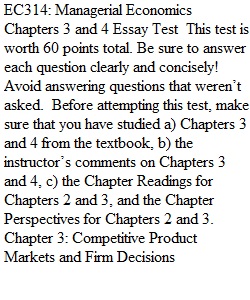


Q EC314: Managerial Economics Chapters 3 and 4 Essay Test This test is worth 60 points total. Be sure to answer each question clearly and concisely! Avoid answering questions that weren’t asked. Before attempting this test, make sure that you have studied a) Chapters 3 and 4 from the textbook, b) the instructor’s comments on Chapters 3 and 4, c) the Chapter Readings for Chapters 2 and 3, and the Chapter Perspectives for Chapters 2 and 3. Chapter 3: Competitive Product Markets and Firm Decisions A. Supply and Demand (15) 1. Explain the difference between an “increase in demand” and an “increase in quantity demanded” (including a discussion of what could cause them to happen). (10) 2. Explain how a free market automatically eliminates a market shortage in the short-run (the price mechanism). (5) B. Overpaying Workers (15) The first widely-cited example of “efficiency wages” is Henry Ford’s more than doubling the wages of his auto workers in 1914. 1. What was Ford’s motivation in doing this? (5) 2. What was the result of the “experiment”? Why did it work? (5) 3. What other reason does the text offer for overpaying workers? (5) Chapter 4: Applications of the economic way of thinking: domestic government and management policies A. Optimum Fringe Benefits 1. Briefly explain how offering fringe benefits for employees can generate profits for firms. Why do some firms not offer fringe benefits? (9) 2. Use the concept of “optimum fringe benefits” to assess the wisdom of Congress mandating that employers offer some specific fringe benefit (day care for children of employees, say) free of charge.(6) B. Minimum Wage (15) The non-economist’s view of the minimum wage seems to be that it forces greedy employers pay poor workers more money, making all workers better off. The “conventional” economic view of an increase in the minimum wage is that, as with most public policies, there are winners (those unskilled workers who keep their jobs and earn more) and losers (those workers who lose their jobs). What is the “unconventional” view and how does it alter that calculus of gains and losses?
View Related Questions